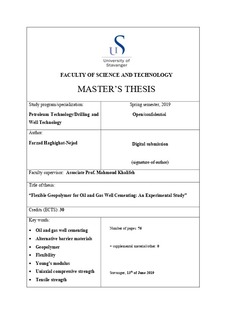| dc.contributor.author | Haghighat-Nejad, Farzad | |
| dc.date.accessioned | 2019-12-18T12:30:12Z | |
| dc.date.available | 2019-12-18T12:30:12Z | |
| dc.date.issued | 2019-06 | |
| dc.identifier.uri | http://hdl.handle.net/11250/2633936 | |
| dc.description | Master's thesis in Petroleum engineering | nb_NO |
| dc.description.abstract | Conventional wellbore cementing materials used in the oil and gas industry are normally brittle, have low tensile strength and suffer from shrinkage. These properties affect the performance of these materials in downhole conditions which can lead to expensive remedial operations, lower production of reservoir fluids, environmental problems and sometimes loss of wells. Therefore, several researches have been performed to find alternative barrier materials which have the potential to substitute the conventional cements. Among these materials geopolymers have shown appealing properties.
In this thesis work, several mechanical properties of geopolymers such as Young’s modulus (flexibility), uniaxial compressive strength and tensile strength have been investigated for the purpose of improving such properties for long-term and making geopolymers applicable for the use in the oil and gas fields. The material used in the experiments of this project is a geopolymer with a combination of fly ash Class F and ground granulated blast furnace slag. Two different flexible additives have been used in the geopolymer to study their effect on the flexibility and other mechanical properties of the material. In addition, two different mixing procedures, namely non-API and API have been used for the preparation of the mixtures.
Based on the experimental results, it was observed that:
• The addition of the two additives to the geopolymer mixtures led to an increase in the flexibility of all the mixtures. However, the highest flexibility was achieved in the geopolymer mixture which included both flexible additives and was prepared with the non-API mixing procedure.
• In general, for all the mixtures in both mixing procedures, the increase in the flexibility resulted in a slight reduction of the compressive strength.
• Comparing the two mixing procedures, the mixtures which were prepared with both the non-API and the API gained nearly similar tensile strength values. Thereby, with increasing flexibility, the tensile strength was reduced when the additives were added to the geopolymer mixtures separately. However, when the combination of the two additives was added to the geopolymer mixtures, the tensile strength increased with increasing flexibility.
• For both the non-API and the API mixing procedures, the geopolymer mixture which included both flexible additives showed the highest value of tensile strength to Young’s modulus ratio. This higher ratio means that the geopolymer mixture has obtained better mechanical properties and as a consequence, better resistance to mechanical damage. | nb_NO |
| dc.language.iso | eng | nb_NO |
| dc.publisher | University of Stavanger, Norway | nb_NO |
| dc.relation.ispartofseries | Masteroppgave/UIS-TN-IEP/2019; | |
| dc.subject | petroleumsteknologi | nb_NO |
| dc.subject | petroleum engineering | nb_NO |
| dc.subject | Young’s modulus | nb_NO |
| dc.subject | oil and gas well cementing | nb_NO |
| dc.subject | alternative barrier materials | nb_NO |
| dc.subject | geopolymer | nb_NO |
| dc.subject | flexibility | nb_NO |
| dc.subject | uniaxial compressive strength | nb_NO |
| dc.subject | tensile strength | nb_NO |
| dc.title | Flexible Geopolymer for Oil and Gas Well Cementing: An Experimental Study | nb_NO |
| dc.type | Master thesis | nb_NO |
| dc.subject.nsi | VDP::Technology: 500::Rock and petroleum disciplines: 510::Petroleum engineering: 512 | nb_NO |
